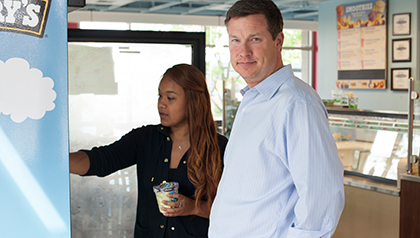AARP Hearing Center

By Vanessa Ho
When Mark Mullet opened a pizzeria and an ice cream shop a few years ago, he wanted his employees to have a retirement savings plan like he’d had at his former banking jobs. Many of his staffers had been working for years, but had put away little.
Every plan he looked at, however, was costly and difficult to set up.
“It’s an expensive, painful and onerous process,” said Mullet, whose Zeeks Pizza and Ben & Jerry’s are in Issaquah, 17 miles east of Seattle. “I think it’s why small businesses aren’t doing it.”
The experience prompted Mullet, who’s also a Democratic state senator, to sponsor a bill to create a state-sponsored retirement savings plan for small businesses. The voluntary system would be under the state’s auspices but operations would be contracted to a private firm.
Mullet’s bill stalled in the Senate this year. A companion bill, sponsored by another small-business owner, state Rep. Larry Springer (D-Kirkland), passed the House with bipartisan support. Mullet said he’ll try again next year.
A recent survey by the Small Business Majority, a nonprofit national advocacy group, found that 78 percent of small businesses in Washington don’t offer a pension plan. And according to the AARP Public Policy Institute, nearly half of the workers in Washington have employers who do not offer a retirement savings plan.
One result is that many workers aren’t saving enough. A recent AARP Washington survey found that nearly 25 percent of boomers have less than $25,000 in savings. Nationally, 45 percent of working-age households—more than 38 million—have no retirement account assets, according to the National Institute on Retirement Security.
“This trend of more and more boomers falling into poverty as they retire is a huge problem,” said Ingrid McDonald, AARP Washington advocacy director.
Plan would be voluntary
With pensions on a decline and many older people struggling to live solely on Social Security, the key is helping workers build a nest egg, McDonald said. The easiest way: a plan that diverts and invests part of their paycheck.
“Human nature is that you have to make it as easy and automatic as possible, or people won’t do it,” McDonald said. “Too often, putting money in the bank is last on the list for people in their 20s and 30s.”
Supporters of the legislative efforts envision a simple and low-cost retirement savings plan. Businesses with up to 100 employees could voluntarily offer it to their employees—regardless of whether they also offered a matching contribution.
Employees could voluntarily participate by paying a low enrollment fee. The plan would be self-sustaining, with no ongoing costs or commingling of private and public pension dollars.
Support came from business and labor groups as well as advocates for older people, including AARP and local Area Agencies on Aging.
Opposition came from financial service firms that questioned whether the government should be allowed to compete with the private sector.
Mullet countered that the marketplace isn’t working, because so few small businesses offer their employees a retirement plan.
The legislative efforts in Washington mirror activities in other states, including Oregon and California.
Eventually, Mullet said, he hopes to offer a retirement plan to his 49 employees, including Sidar Tun, his general manager at Ben & Jerry’s. Tun, 26, of Issaquah, has worked in food, retail and orchard jobs since she was a teen. She wants to build a retirement fund, but none of her jobs have had a savings plan. She knows little about investing.
“To be able to have your employer give you the layout would be a relief of some of the headache,” Tun said. “I want to make sure I’m financially OK.”
Vanessa Ho is a writer living in Seattle, Wash.































































